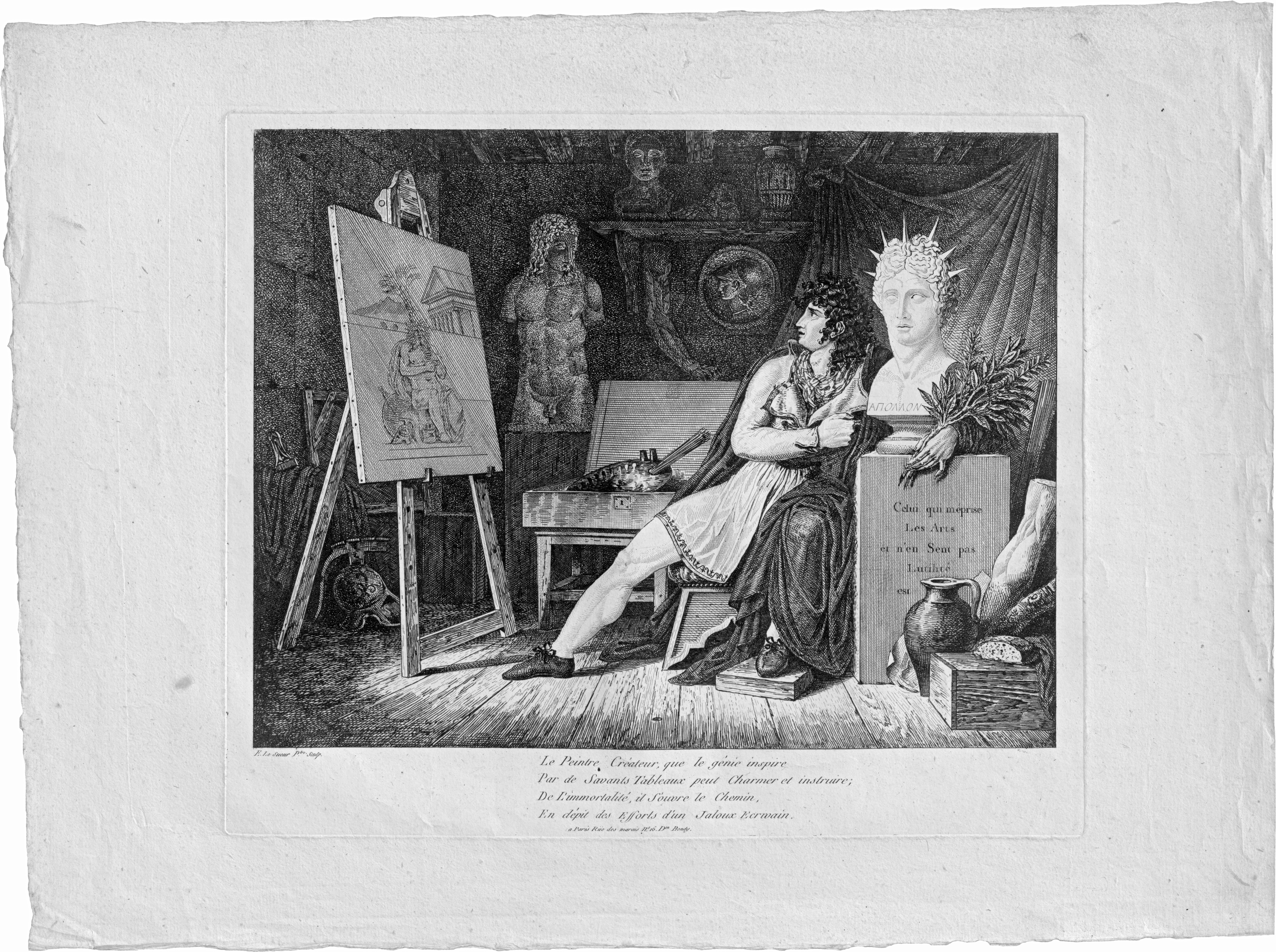Loading the page ...
Pierre-Etienne Lesueur
(active in Paris 1790–1810)
Caricature of Art Criticism. Etching. 33 x 39 cm. Circa 1795. Unrecorded. Johann Wolfgang von Goethe, Rezension einer Anzahl französischer satirischer Kupferstiche: Text, Bild, Kommentar. With an introduction edited by Klaus H. Kiefer, Munich 1988, p. 137 f., no. 55.
An artist in classical-style dress with a curly hairstyle in the fashion of the revolutionary period in France contemplates his work on an easel. His posture is in accordance with neo-classical principles: his head is in profile view and the depth of his feelings is manifested in his right hand resting on his heart, while his left arm embraces a bust of Apollo and his outstretched hand clasps a laurel branch. Fragments or casts of classical sculptures can be seen in the studio. Affixed to the wall is a medallion with the head of Minerva, the protector of the arts. Palette and brush lie unused in a paint box, but the laurel branch seems to be sharpened and the hand holds it like it were a drawing pen. The inscription on the plinth below the bust reads “Celui qui méprise les arts et n’en sent pas l’utilité est”, the remainder of it being concealed by a jug, which as a metaphorical “cruche” would suggest the following translation: “He who despises the arts and fails to see their usefulness is a fool.” The caption can be roughly translated as: “The creative artist, whom his genius inspires with learned images, can charm and instruct, to immortality he paves his way, despite the efforts of a jealous writer.” There is evidently some sort of controversy raging between the creative artist and a malevolent art critic. The easel painting shows a god – Zeus? – sat in front of a classical backdrop. Could this possibly be the ancient hero’s paradise Elysium, accessible only to a few and at the behest of Zeus, which would take up the theme of immortality referred to in the caption? Or is it merely an ideal image of antiquity? Whatever the case, the artist contemplates this place of longing reverently and with deep emotion.
None other than Johann Wolfgang von Goethe discussed this extraordinarily rare caricature in 1797 in his essay Rezension einer Anzahl französischer satirischer Kupferstiche. Goethe included the work in his chapter entitled “Against Enemies of Artists”, but he did not know who the artist and the “écrivain” might be. In his adaptation of Goethe’s text Klaus Kiefer comes to the conclusion that the critic mentioned was the writer, Louis-Sébastien Mercier, whose polemical attitude towards neo-classical art made him the subject of several caricatures. The artist portrayed in a fashionable classical tunic is, therefore, Jacques Louis David. In contrast to Mercier, David was a passionate advocate of the return to antiquity who, in 1794, designed an official classical-style outfit – similar to that worn by the artist in the picture – for French civil servants (Johann Wolfgang Goethe, Rezension einer Anzahl französischer satirischer Kupferstiche: Text, Bild, Kommentar. With an introduction edited by Klaus H. Kiefer, Munich 1988, p. 137 f., no. 55).
On the basis of this reading the author of the present print, who signs himself E. Le Sueur, could be the painter, Pierre-Etienne Lesueur. He is mentioned as being a pupil of the landscape painter, Jean Pillement, and a member of David’s entourage. He participated in Salon exhibitions between 1791 and 1810 and was a member of the Société républicaine des arts. Following in David’s footsteps, he also endeavoured to bring about a clothing reform that was of programmatic significance for the revolutionary leaders (see Philippe de Carbonnières, Lesueur. Gouaches revolutionnaires, Collections du Musée Carnavalet, Paris 2005, p. 34). The collection preserved by the Musée Carnavalet includes some of his designs, such as that for the members of the Council of the Five Hundred (inv. no. D.3235) and the uniform of a judge after David (inv. no. D.3238). Lesueur is also credited with a drawing, now in the Bibliothèque Nationale, of the execution of Louis XVI, a multi-figured depiction influenced by David’s Ballroom Oath (cf. Warren Roberts, Jacques-Louis David and Jean-Louis Prieur: revolutionary artists, New York 2000, p. 266 ff.). A superb, contrasting impression, with full margins. Minor ageing and traces of handling, slightly foxed in the white margin, otherwise in excellent, pristine condition.
Contact us for further information